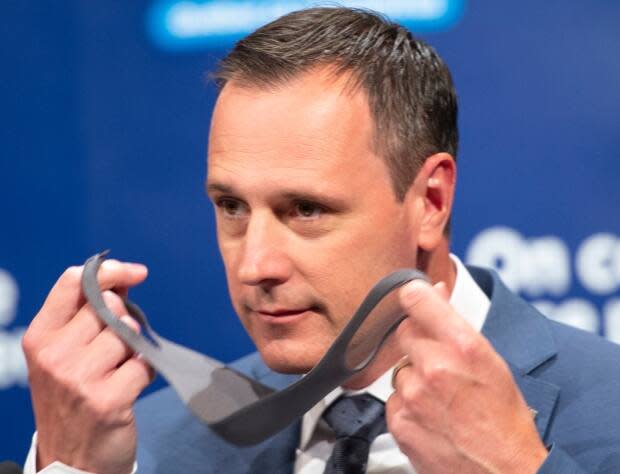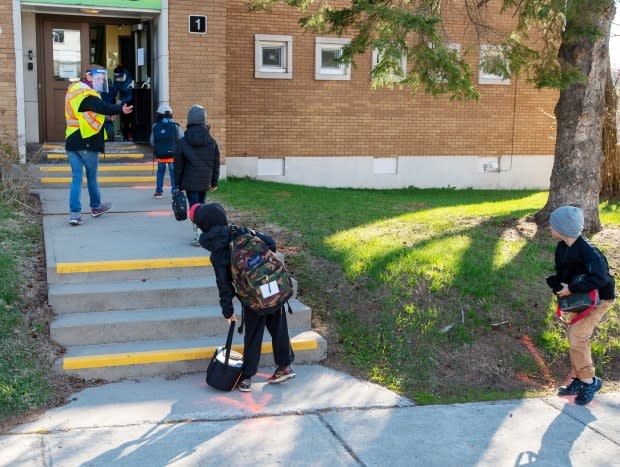What's behind the changes in Quebec's new back-to-school plan?
There is a lot riding on Quebec's back-to-school plan, the latest version of which was revealed Monday by Education Minister Jean-François Roberge.
Broadly stated, it has to accomplish two things: return as many students to the classroom as possible this fall, and do this without triggering a second wave of infections that could imperil the provincial health-care system.
Roberge took an initial crack at squaring this circle in June, releasing a plan that made no mention of masks and proposed keeping students in small groups to limit outbreaks.
The upside of that plan was that it made clear to parents there was going to be in-class education in September, which, along with vital implications for the development of children, has significant economic and social consequences.

The downside was that the plan was light on details and was quickly eclipsed by the rapidly evolving science on COVID-19.
Earlier this week, after weeks of increasingly urgent questions from teachers and parents, Roberge announced major revisions to the government's strategy for mitigating the risks of returning to school.
While the new plan addresses many of the major concerns of health experts, there are some holes they hope will be addressed in subsequent revisions.
Landmark study
The biggest issue about the first draft of Roberge's back-to-school plan was the absence of any mask requirements for students.
Ministry officials were working from the assumption, not unreasonable at the time, that children are not potent vectors of the disease.
In July, however, researchers from South Korea published an early version of a study that found children and teens aged 10 to 19 transmit the virus as much as adults do. It also found that while children under the age of 10 can spread the virus, they don't do so as much as older children.
The study, which analyzed case histories of nearly 60,000 people who had been in contact with a COVID-19 patient, helped confirm numerous smaller studies that came to similar conclusions.
"It has really changed people's approaches, especially when it comes to wearing masks," said Dr. Earl Rubin, who heads the infectious disease unit at the Montreal Children's Hospital.
The updated version of Quebec's plan, released Monday, is in line with the latest research: students in Grade 5 and up will have to wear a mask almost everywhere inside, unless they're seated at their desks.

Given that infection rates are still relatively high in Quebec, some experts have suggested students should wear their masks in the classroom as well, at least for the start of the year.
"I think this is the time to push for maximum intervention to reduce the risk of viral transmission," said Dr. Matthew Oughton, an infectious disease specialist with the McGill University Health Centre in Montreal.
"Once we have a sense of how things are doing in school, then there can be some room for flexibility."
The other big change from the June draft is doing away with the concept of "bubbles."
Initially, it was thought keeping students in small sub-groups of six would limit the size of outbreaks. But many teachers worried bubbles would be a nightmare to enforce, and medical experts said their value was minimal.
"Whether you have small bubbles or not, the entire class would be quarantined if there was a case in the classroom," said Dr. Caroline Quach, a pediatric infectious disease specialist and epidemiologist at the Sainte-Justine children's hospital in Montreal.
Instead of bubbles, students will be able to interact with anyone in their class, but not with students from other classes.
Positive reception, but some fuzziness
The reaction, so far, to Roberge's updated plan has been fairly positive from teachers, administrators and opposition politicians.
"When you compare it with what was presented in the spring, this one is a lot more coherent," said Josée Scalabrini, president of the Fédération des syndicats de l'enseignement, an association of 34 teachers unions.
WATCH | Quebec's education minister explains back-to-school plan:
Unlike in Ontario, there has been no outcry — yet — over Quebec's intention to keep class sizes at their usual pre-pandemic levels.
Public health authorities in Toronto are recommending schools there reduce class size as much as possible in order to limit transmission, especially in younger grades where masks are not mandatory.
The Ontario government has refused to budge from its plan to return to full-size classes in the fall, but opposition is growing. A petition demanding smaller class sizes in elementary schools has gathered more than 200,000 signatures.
Quach, who has provided advice to the Quebec government over the course of the pandemic, acknowledged that more students in a classroom means a higher risk of transmission.
"Yes, we could decrease the size of classes, but then you would need more teachers, which I think is not possible at this point in time," she said.
Quach believes full-size classes can be relatively safe if a number conditions are met, including low community transmission and rapid testing and tracing.
She also suggested that having desks in rows with students facing forward, rather than toward each other, could limit their exposure to droplets, which is thought to be the main way the virus spreads outside medical settings.
Quebec's guidelines, though, make no mention of how to position desks. Once inside the classroom, students will be able to remove their masks and won't be required to distance from each other, but will have to stay two metres away from their teacher.

Rubin, who also advised the government on its back-to-school plan, called the absence of guidelines on class size "confusing."
"Sometimes there are 30 kids in the class," he said. "What are the physical parameters of that room that will allow 30 kids to sit, and how far apart will they be from the next student?"
Rubin said it will take one to two incubation periods of the virus — the equivalent of two to four weeks — before public health officials will be able determine the effect that reopening schools will have on infection rates.
Like the first school plan, he said, this latest version is also likely to change, depending on what happens in those first few weeks.
"The thing with [COVID-19] is what we know today may be different than tomorrow and certainly different than yesterday," Rubin said. "Things are always changing and, because of that, the recommendations will change."



